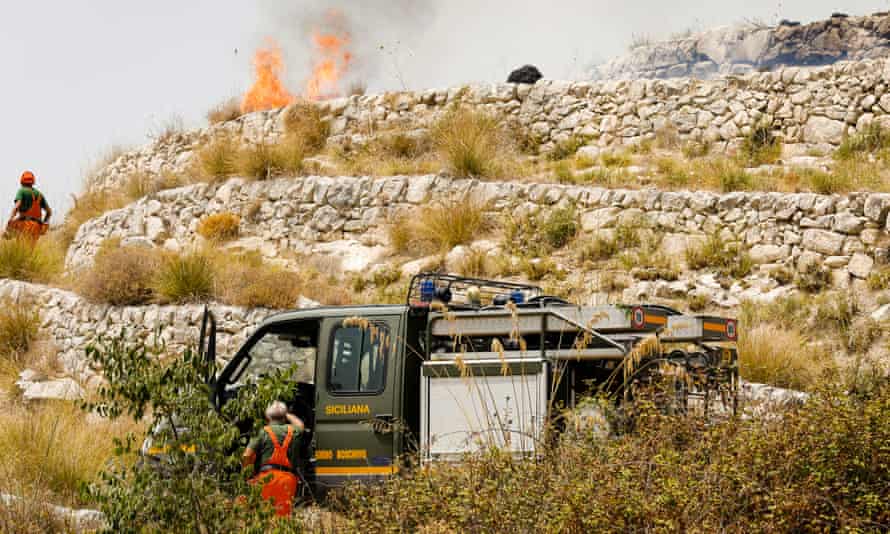As with most farmers living in the remote towns of the Aspromonte mountain range in Calabria, southern Italy, Nicola Fortugno’s land was his life. The 79-year-old refused to be evacuated when flames engulfed Piraino, a hamlet surrounded by pine forest above the town of Cardeto, on Wednesday. Instead, he stayed at home to try to save his animals and crops. His burnt, lifeless body was found by firefighters.
“I used to see Nicola whenever he came to town to go to the chemist or see the doctor,” said Francesca Crea, owner of the newspaper shop in Cardeto. “His death is very painful as we’re a community of mostly farmers, people who make great sacrifices for a small patch of land – the animals are their treasures.”
Communities across the Aspromonte mountains are counting the heavy costs to livelihoods and the environment as forest fires rage for the 10th day in a row. In recent days, efforts to extinguish the fires, which are also plaguing Sicily, Campania, Puglia, Basilicata and the island of Sardinia, have been hampered by hot winds amid an intense, protracted heatwave that could see Italy break European temperature records.
Wildfires have also ravaged large areas in southern Europe and Turkey as the region endures its most extreme heatwave in three decades.
The heatwave is forecast to persist for the next few days, with temperatures hitting up to 41C (106F).
The wildfires that affected the area of Cardeto were still smouldering on Thursday morning. Others were just beginning. The consequences were strikingly visible in the scorched land, blackened rocks and dozens of burnt or collapsed trees.
As of Thursday night, 60 fires were burning across Calabria, the highest number in Italy, prompting the government led by the prime minister, Mario Draghi, to announce a national emergency plan. “We will put in motion a programme of compensation for the people and businesses affected, together with an extraordinary reforestation and security plan,” Draghi’s office said in a statement.
Five people are so far confirmed to have died in the fires: four in Calabria and one in Sicily, where a 30-year-old farmer was crushed by his tractor as he tried to put out flames on his farm in Paterno, a town near Catania.

The deaths in Calabria have all occurred in the Aspromonte mountains, home to a vast national park that contains an area of centuries-old beech trees and which was declared this year as a Unesco world heritage site. A woman and her nephew were killed as they tried to save their olive grove; a 76-year-old man died after leaving his home in an attempt to safeguard his allotment.
Meanwhile, hundreds of pilgrims who had been walking towards a religious site in the town of San Luca were forced to turn back when flames enveloped roads.
Angela Tesorone and her brother, Alfonso, fled Roccaforte del Greco, a town of about 400 residents in the centre of the Aspromonte national park, on Monday night as flames took hold.
“These are the worst wildfires I have ever experienced,” said Tesorone, who owns a business that produces olive oil. “People have died; animals have died; acres and acres of forest and farmland have been destroyed. All that’s left are ashes.”
As the scale of destruction is assessed, anger is also mounting over the handling of the wildfires, with many Calabrians pointing to a litany of errors – including the scrapping of the state forestry corps by Matteo Renzi’s government in 2016 – which they believe have exacerbated the situation amid this summer’s heatwave.
Others say the reinforcements from central government to help fight the fires have come too late. The army was dispatched to Calabria this week, as were staff from Italy’s civil protection authority. In addition, 2,500 forestry experts and volunteers from Calabria Verde, a council-owned company entrusted with taking care of the region’s forests, are involved in the firefighting effort.
“The entire squad is working across the territory,” said Giuseppe Oliva, the special commissioner for Calabria Verde. “This year the climatic conditions have made the fires very difficult to fight.”
Coldiretti, Italy’s main farmers’ association, said earlier this month that the number of wildfires across the country has tripled in 2021 compared with the yearly average between 2008 and 2020.
Authorities estimate that almost 57% fires in these conditions are malicious, either caused by arsonists or those wanting to benefit from state funds. In some cases, the fires have been triggered by young people simply wanting to see the emergency services in action.
“Less than 2% are caused naturally, for example by a lightning strike. For 4.4% the cause is undetermined and 22% are unclassifiable situations in which it is difficult to know what triggered the fire,” said Roberto Cingolani, Italy’s ecological transition minister.
Sitting outside a bar in a hamlet close to Cardeto, Marco Bruno had no doubt that human negligence has had its role in the fires across the Aspromonte mountains. In 2003 – when thousands died and large swathes of forest were destroyed by wildfires in Europe amid an intense heatwave – the maintenance of the Aspromonte’s forests was entrusted to non-profit organisations. The organisations would only receive the bulk of their payments if they succeeded in limiting fires in their designated areas to less than 1%. The system, which led to a significant reduction in the number of wildfires, was abolished in 2013.
“I’ve never seen anything like the fires this summer,” said Bruno. “And it’s all down to bad management of the forests. We used to have a system that worked, experienced people who knew what they were doing. Now there is no sufficient monitoring or maintenance, and these are the consequences.”
Average Rating